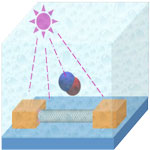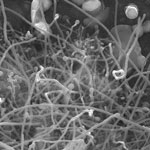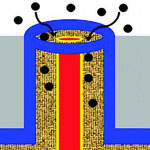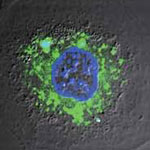Showing Spotlights 73 - 80 of 319 in category All (newest first):
 Single-walled carbon nanotubes arguably are the ultimate biosensor among nanoscale semiconducting materials due to their high surface-to-volume ratio and unique electronic structure. After more than a decade of excitement though, more and more researchers in the nanotube field believe that pristine SWCNTs are very limited as a sensing material. Ironically the ultrahigh sensitivity of SWCNTs is easily compromised by various unintentional contaminants from the device fabrication process as well as the ambient environment. As a result, significant efforts have been focused on all kinds of ways to functionalize or decorate nanotubes with other species in order to improve their sensitivity. Researchers have now shown that applying continuous in situ ultraviolet light illumination during gas detection can enhance a SWCNT-sensor's performance by orders of magnitude under otherwise identical sensing conditions.
Single-walled carbon nanotubes arguably are the ultimate biosensor among nanoscale semiconducting materials due to their high surface-to-volume ratio and unique electronic structure. After more than a decade of excitement though, more and more researchers in the nanotube field believe that pristine SWCNTs are very limited as a sensing material. Ironically the ultrahigh sensitivity of SWCNTs is easily compromised by various unintentional contaminants from the device fabrication process as well as the ambient environment. As a result, significant efforts have been focused on all kinds of ways to functionalize or decorate nanotubes with other species in order to improve their sensitivity. Researchers have now shown that applying continuous in situ ultraviolet light illumination during gas detection can enhance a SWCNT-sensor's performance by orders of magnitude under otherwise identical sensing conditions.
Apr 10th, 2012
 Of all the methods that have been developed to produce carbon nanotubes (CNTs), including arc discharge, laser ablation, and chemical vapor deposition (CVD), CVD is the most technically important and the most widely used in industry. Using the CVD process, manufacturers can combine a metal catalyst such as iron or nickel with reaction gases such as hydrocarbon to form carbon nanotubes inside a high-temperature furnace. Semiconductor nanoparticles such as silicon carbide, germanium and silicon have also been used for single CNT catalysis. However, these catalyst materials are usually expensive and need to be of high purity in order to be useful for the growth of carbon nanotubes. Researchers have now found that cheap and plentiful calcium silicate can absorb carbon species and grow multi-walled carbon nanotubes.
Of all the methods that have been developed to produce carbon nanotubes (CNTs), including arc discharge, laser ablation, and chemical vapor deposition (CVD), CVD is the most technically important and the most widely used in industry. Using the CVD process, manufacturers can combine a metal catalyst such as iron or nickel with reaction gases such as hydrocarbon to form carbon nanotubes inside a high-temperature furnace. Semiconductor nanoparticles such as silicon carbide, germanium and silicon have also been used for single CNT catalysis. However, these catalyst materials are usually expensive and need to be of high purity in order to be useful for the growth of carbon nanotubes. Researchers have now found that cheap and plentiful calcium silicate can absorb carbon species and grow multi-walled carbon nanotubes.
Apr 2nd, 2012
 Various types of nanostructures are used in the development of nanosensors: nanoparticles, nanotubes, nanorods, two-dimensional materials like graphene, embedded nanostructures, porous silicon, and self-assembled materials. For instance, gas sensors often operate by detecting the subtle changes that deposited gas molecules make in the way electricity moves through a surface layer. Researchers have fabricated gas sensors based on carbon nanotube-based field effect transistors, which can detect electrical potential changes around them. While these and related sensing schemes can be all-electronic - i.e., not requiring optical readout - they all require sophisticated nanolithographic techniques to isolate, identify, and integrate electrical contact to the active nanosensor. Researchers have now presented a nanoscale 3D architecture that can afford highly sensitive, room temperature, rapid response, and all-electronic chemical detection.
Various types of nanostructures are used in the development of nanosensors: nanoparticles, nanotubes, nanorods, two-dimensional materials like graphene, embedded nanostructures, porous silicon, and self-assembled materials. For instance, gas sensors often operate by detecting the subtle changes that deposited gas molecules make in the way electricity moves through a surface layer. Researchers have fabricated gas sensors based on carbon nanotube-based field effect transistors, which can detect electrical potential changes around them. While these and related sensing schemes can be all-electronic - i.e., not requiring optical readout - they all require sophisticated nanolithographic techniques to isolate, identify, and integrate electrical contact to the active nanosensor. Researchers have now presented a nanoscale 3D architecture that can afford highly sensitive, room temperature, rapid response, and all-electronic chemical detection.
Mar 21st, 2012
 If you are a blind computer user you have to rely on electronic Braille displays which typically allow you to see only one line at a time, no matter what you were doing. Such a Braille display is a tactile, electro-mechanical device for displaying Braille characters, consisting of a row of special 'soft' cells. A soft cell has 6 or 8 pins made of metal or nylon; pins are controlled electronically to move up and down to display characters as they appear on the computer display. A number of cells are placed next to each other to form a soft or refreshable braille line. As the little pins of each cell pop up and down they form a line of braille text that can be read by touch. Researchers have now have fabricated a Braille sheet display by integrating organic thin-film transistor drivers, organic static random-access memory, and carbon nanotube-based actuators.
If you are a blind computer user you have to rely on electronic Braille displays which typically allow you to see only one line at a time, no matter what you were doing. Such a Braille display is a tactile, electro-mechanical device for displaying Braille characters, consisting of a row of special 'soft' cells. A soft cell has 6 or 8 pins made of metal or nylon; pins are controlled electronically to move up and down to display characters as they appear on the computer display. A number of cells are placed next to each other to form a soft or refreshable braille line. As the little pins of each cell pop up and down they form a line of braille text that can be read by touch. Researchers have now have fabricated a Braille sheet display by integrating organic thin-film transistor drivers, organic static random-access memory, and carbon nanotube-based actuators.
Mar 16th, 2012
 Carbon nanotubes, like the nervous cells of our brain, are excellent electrical signal conductors and can form intimate mechanical contacts with cellular membranes, thereby establishing a functional link to neuronal structures. There is a growing body of research on using nanomaterials in neural engineering. Now, researchers have, for the first time, explored the impact of carbon nanotube scaffolds on multilayered neuronal networks. Up to now, all known effects of carbon nanotubes on neurons - namely their reported ability to potentiate neuronal signaling and synapses - have been described in bi-dimensional cultured networks where nanotube/neuron hybrids were developed on a monolayer of dissociated brain cells.
Carbon nanotubes, like the nervous cells of our brain, are excellent electrical signal conductors and can form intimate mechanical contacts with cellular membranes, thereby establishing a functional link to neuronal structures. There is a growing body of research on using nanomaterials in neural engineering. Now, researchers have, for the first time, explored the impact of carbon nanotube scaffolds on multilayered neuronal networks. Up to now, all known effects of carbon nanotubes on neurons - namely their reported ability to potentiate neuronal signaling and synapses - have been described in bi-dimensional cultured networks where nanotube/neuron hybrids were developed on a monolayer of dissociated brain cells.
Mar 2nd, 2012
 Carbon nanotubes (CNTs) offer a number of advantages for delivering drugs to specific locations inside the body which suggest that they may provide an improved result over nanoparticles. They have a larger inner volume which allows more drug molecules to be encapsulated, and this volume is more easily accessible because the end caps can be easily removed, and they have distinct inner and outer surfaces for functionalization. Recent research has shown the ability of CNTs to carry a variety of molecules such as drugs, DNA, proteins, peptides, targeting ligands etc. into cells - which makes them suitable candidates for targeted delivery applications. Researchers have now developed a unique two-dye labeling method to directly track the release process of a anti-cancer drug from carbon nanotube carriers in living cells.
Carbon nanotubes (CNTs) offer a number of advantages for delivering drugs to specific locations inside the body which suggest that they may provide an improved result over nanoparticles. They have a larger inner volume which allows more drug molecules to be encapsulated, and this volume is more easily accessible because the end caps can be easily removed, and they have distinct inner and outer surfaces for functionalization. Recent research has shown the ability of CNTs to carry a variety of molecules such as drugs, DNA, proteins, peptides, targeting ligands etc. into cells - which makes them suitable candidates for targeted delivery applications. Researchers have now developed a unique two-dye labeling method to directly track the release process of a anti-cancer drug from carbon nanotube carriers in living cells.
Mar 1st, 2012
 For years it has been known that scaling bulk silicon transistors would be extremely challenging, if not impossible, when lengths close in on 15 nm. Already, attention has turned to 3D transistor design and silicon-on-insulator (SOI) devices to improve the scalability of silicon technology. Carbon nanotube (CNT) transistors have been touted as a possible replacement for silicon devices but the crucial question so far has been if CNT transistors can offer performance advantages over silicon at sub-10 nm lengths? New experimental results from IBM Research are indicating that the answer is 'yes'. The findings by the research team defied the theoretical projections and exhibited encouraging performance for a device with a 9 nm channel length.
For years it has been known that scaling bulk silicon transistors would be extremely challenging, if not impossible, when lengths close in on 15 nm. Already, attention has turned to 3D transistor design and silicon-on-insulator (SOI) devices to improve the scalability of silicon technology. Carbon nanotube (CNT) transistors have been touted as a possible replacement for silicon devices but the crucial question so far has been if CNT transistors can offer performance advantages over silicon at sub-10 nm lengths? New experimental results from IBM Research are indicating that the answer is 'yes'. The findings by the research team defied the theoretical projections and exhibited encouraging performance for a device with a 9 nm channel length.
Feb 9th, 2012
 Noble metal nanoparticles such as gold, silver or platinum are widely used by scientists to develop novel applications in sensing, energy, spectroscopy, and catalysis. For instance, the combination of metal nanoparticles and carbon nanomaterials - graphene and nanotubes - has met with great interest in the area of biosensor applications as well as composite fabrication for light-energy conversion. In these applications, researchers make use of the formation of organic/inorganic hybrid nanosystems by incorporating metal nanoparticles in or onto the graphitic structures of carbon nanotubes or graphene. Researchers have now discovered a novel phenomenon whereby graphene can be catalytically transformed into carbon nanotubes by gold nanoparticles at relatively low temperatures.
Noble metal nanoparticles such as gold, silver or platinum are widely used by scientists to develop novel applications in sensing, energy, spectroscopy, and catalysis. For instance, the combination of metal nanoparticles and carbon nanomaterials - graphene and nanotubes - has met with great interest in the area of biosensor applications as well as composite fabrication for light-energy conversion. In these applications, researchers make use of the formation of organic/inorganic hybrid nanosystems by incorporating metal nanoparticles in or onto the graphitic structures of carbon nanotubes or graphene. Researchers have now discovered a novel phenomenon whereby graphene can be catalytically transformed into carbon nanotubes by gold nanoparticles at relatively low temperatures.
Feb 8th, 2012
 Single-walled carbon nanotubes arguably are the ultimate biosensor among nanoscale semiconducting materials due to their high surface-to-volume ratio and unique electronic structure. After more than a decade of excitement though, more and more researchers in the nanotube field believe that pristine SWCNTs are very limited as a sensing material. Ironically the ultrahigh sensitivity of SWCNTs is easily compromised by various unintentional contaminants from the device fabrication process as well as the ambient environment. As a result, significant efforts have been focused on all kinds of ways to functionalize or decorate nanotubes with other species in order to improve their sensitivity. Researchers have now shown that applying continuous in situ ultraviolet light illumination during gas detection can enhance a SWCNT-sensor's performance by orders of magnitude under otherwise identical sensing conditions.
Single-walled carbon nanotubes arguably are the ultimate biosensor among nanoscale semiconducting materials due to their high surface-to-volume ratio and unique electronic structure. After more than a decade of excitement though, more and more researchers in the nanotube field believe that pristine SWCNTs are very limited as a sensing material. Ironically the ultrahigh sensitivity of SWCNTs is easily compromised by various unintentional contaminants from the device fabrication process as well as the ambient environment. As a result, significant efforts have been focused on all kinds of ways to functionalize or decorate nanotubes with other species in order to improve their sensitivity. Researchers have now shown that applying continuous in situ ultraviolet light illumination during gas detection can enhance a SWCNT-sensor's performance by orders of magnitude under otherwise identical sensing conditions.
 Subscribe to our Nanotechnology Spotlight feed
Subscribe to our Nanotechnology Spotlight feed





